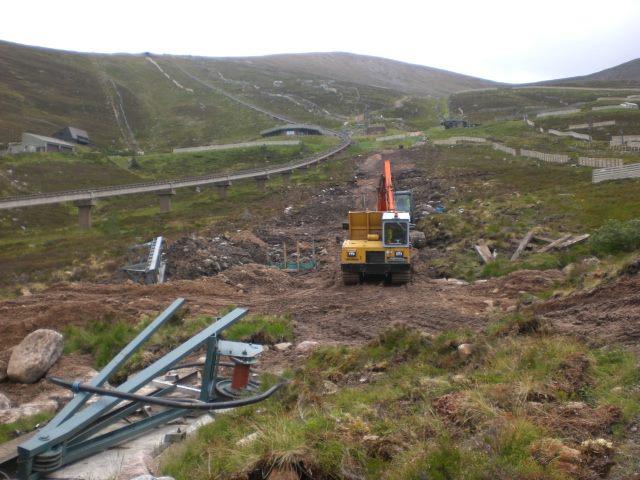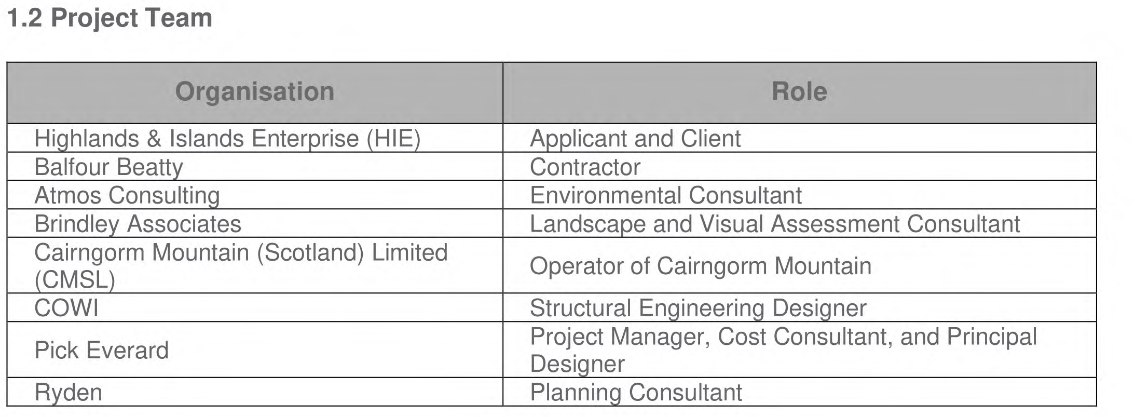
Photo courtesy of the Save the Ciste campaign showing the Funicular Viaduct from the washing line tow. Is this what the mountain will look like when work commences?
The development of the Business Case to repair of the funicular (see here) was shrouded in secrecy. This post takes a look at what Highland and Islands Enterprise’s responses to two Freedom of Information requests tells us about the whole process
After the funicular was shut for safety reasons, HIE commissioned a report from COWI engineering consultants on what had gone wrong called “Cairngorm Funicular Railway – Viaduct Appraisal”. HIE received the report in December 2018 but has since refused several requests to release the report, claiming that it would be published shortly – a valid reason for withholding information. 20 months later the report had still not been published it so, on 3rd September, I submitted a further request with the intention of taking this to appeal if refused. HIE’s repled as follows:
“We can confirm that the COWI Cairngorm Funicular Railway – Viaduct Appraisal Report, December 2018, is being withheld under Section 30(c) where disclosure would otherwise prejudice substantially, or be likely to prejudice substantially, the effective conduct of public affairs. We are currently consulting with relevant third parties prior to release although it is our intention to disclose the report as soon as possible and as soon as that consultation is complete.”
“The use of this exemption requires HIE to consider the public interest. It has been decided that, in this case and at the current time, the public interest is ensuring HIE remains in a position to achieve the best possible outcome for Cairngorm Mountain in terms of securing value for public money as well as a viable and sustainable future for the resort and surrounding area.”
Starting with the 1st para., “disclosure would otherwise prejudice substantially, or be likely to prejudice substantially, the effective conduct of public affairs”. At the recent Audit and Post-legislative Scrutiny Committee in the Scottish Parliament (see here) Audit Scotland again confirmed HIE was taking legal action to recover money from “the design and build aspects of the funicular”. It appears that HIE is using this to justify withholding the report. However, even if HIE cannot yet reveal the reasons why the support pillars to the funicular moved, it could explain exactly what the engineers said needed to be done to fix it. It has never done that and there is still no explanation in the Business Case.
Let’s examine the second paragraph. Despite the huge press and public interest, HIE have decided it is not in the public interest to release the report!
HIE’s attempt to justify this “in terms of securing value for public money” is laughable. While announcing the funicular would be repaired, HIE also stated the multi-million pound contract had been awarded to Balfour Beatty. The business case reveals they had done this through a civil engineering framework contract operated by Scape Scotland (see here). This has just one contractor on it, Balfour Beatty, who was also involved in designing what repair work was needed. So, Balfour Beatty designed the work – presumably having been given sight of the COWI report – then costed it, without any form of testing whether other solutions might have worked or whether the £16m cost was “value for money”. Release of the COWI report is essential to demonstrate whether Balfour Beatty’s estimates for the capital costs – which the business case reveals went up from £14.6m in February to £16.16m in July – represents value for money. HIE is still promising to release it soon.
The explanation in the Business Case of why Balfour Beatty was appointed contradicts what the interim Chief Executive Officer of HIE, Carroll Buxton, stated in a review of an FOI request abou costs of repair last year (30/08/2019):

So a year ago HIE was arguing forcefully it could not start procuring the repairs until AFTER the Scottish Government had made a decision. Either it lied or at some point soon afterwards it did a 180° about turn. Balfour Beatty was mentioned as the contractor in the Construction Method Statement that accompanied the planning application to repair the funicular (see here) that was lodged on 12th March: Balfour Beatty must have been “appointed” months prior in order to specify the work properly.
Balfour Beatty must have been “appointed” months prior in order to specify the work properly.
HIE also claims its refusal to release the COWI report is in the public interest to enable “a viable and sustainable future for the resort and the surrounding area”. Since the funicular was built the Cairngorm Mountain business has had to be bailed out by HIE, i.e. the taxpayer, once in 2008 and again in 2018. The whole history proves the funicular is not financially viable or sustainable. That is confirmed by the £32m approved by the Scottish Government last week including a minimum revenue subsidy of over £9m in the next 5 years and, presumably, similar amounts every 5 years after until the next serious breakdown.
HIE’s refusal to release the COWI report is part of a wider addiction to secretive decision-making processes which explains many of the disasters at Cairn Gorm. Without transparency and public scrutiny, CairnGorm Mountain will never have a sustainable future but lurch from one crisis to the next.

In the case of a company continuing to trade while knowingly insolvent , all incumbent directors can be legally disbarred from acting in this capacity within any other company. Quango officials – the ones responsible for the continued and secretive misapplication of public funds at Cairngorm (and elsewhere across Scotland ) – should be held fully and personally accountable for choices they make. If full surveillance and investigative mechanisms no longer appear functional at Holyrood, to reign in public officials who appear to have acted unwisely, why has this state of affairs been tolerated by MSP’s .? Possibilities for scrutiny and censure appear to have been “stitched up”. The electorate are left no mechanism by which they can ensure Enterprise agency staff and local officials are held fully and personally to account. Individuals who have proved “wanting” are too seldom disbarred from Public Office when things go wrong. If FoI requests in Scotland are sidelined, redacted or ignored , no safeguards against failure remain in Scotland today . The process of decision-making by public officials is now given full authority to remain fully hidden? This past decade the splurge of expenditure of public money on some grandiose projects in Scotland appears to benefit firms and individuals in ways that are blatant, excessive, random, and very unlikely to be subjected to proper scrutiny . Cronyism is never censured. The wider public interest is subverted. Scots people deserve better.
Very clear description of the process and how public accountability has been shelved to suit….pockets?…reputations compromised by lies?….complicit support from Scottish Gov. which is unidentified if the report remains ‘closed’?….Scottish Gov. seeking to hide behind private company until after the next Scottish election? ….you name it: this stinks.